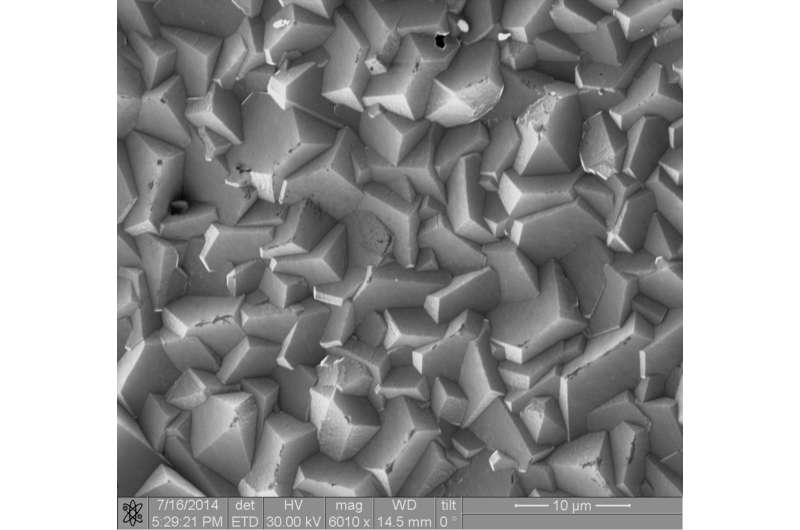Photomicrograph of a polycrystalline diamond film is shown. Credit: Tomsk Polytechnic University
A research team of Tomsk Polytechnic University is participating in the upgrade of the Large Hadron Collider (LHC) at the European Center for Nuclear Research (CERN). The TPU scientists were assigned to analyze operating detectors and to develop more reliable next-generation diamond detectors to record the collisions of elementary particles accelerated to velocities close to light speed, which occur every 28 nanoseconds.
"Energies that arise during the experiments at the Large Hadron Collider are the highest in the world. The conditions of the experiments are also unusual—the collisions of particles occur every 28 nanoseconds. Accordingly, we the most reliable and accurate detectors for fast responses to these collisions," says Professor Pavel Karataev, Royal Holloway University (UK), head of the Electromagnetic Radiation Laboratory, RASA Center at TPU and one of the supervisor of TPU group at CERN.
At CERN, the research team is part of the Beam Radiation Instrumentation and Luminosity (BRIL) project of the CMS experiment, which is responsible for measuring luminosity, machine induced background (MIB), and beam timing.
In the framework of BRIL, the scientists are working to improve the reliability of the existing system of BCML (Beam Condition Monitor Leakage) diamond sensors that ensure safety at LHC, as well as to test their own detectors based on synthetic diamonds produced at the TPU Institute of High Technology Physics.
According to Pavel Karataev, in order to continue experiments at the Large Hadron Collider in the short run, scientists are going to enhance the intensity of the proton beam by a factor of 10. If sensors are not prepared for such loads, it will be impossible to record particle collisions and measure the luminosity of the beam. TPU scientists have already measured all the detectors that currently operate at CERN.
"Now, we are irradiating them with particles. We will irradiate the detectors for two months at different loads of applied voltage and radiation to determine an individual operating voltage for each detector, predict the wear rate, the average service life at certain capacities, and other parameters," says Vitaly Okhotnikov, a research engineer who supervises the BCML project at CERN.
The scientists also set an objective to develop detectors based on synthetic diamonds and produce them at TPU. They will feature more predictable wear resistance and, most importantly, their operating parameters will also be predictable. In addition, the TPU scientists will take part in the upgrade of the safety system of BCML CERN. The system automatically disables the LHC accelerators when sensors record excessive levels of luminosity and radiation. After its upgrade, it will be easier to replace inappropriate sensors while minimizing contact with emitted radiation.
Provided by Tomsk Polytechnic University
























